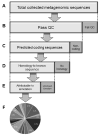Modeling microbial community structure and functional diversity across time and space
- PMID: 22553907
- PMCID: PMC3396557
- DOI: 10.1111/j.1574-6968.2012.02588.x
Modeling microbial community structure and functional diversity across time and space
Abstract
Microbial communities exhibit exquisitely complex structure. Many aspects of this complexity, from the number of species to the total number of interactions, are currently very difficult to examine directly. However, extraordinary efforts are being made to make these systems accessible to scientific investigation. While recent advances in high-throughput sequencing technologies have improved accessibility to the taxonomic and functional diversity of complex communities, monitoring the dynamics of these systems over time and space - using appropriate experimental design - is still expensive. Fortunately, modeling can be used as a lens to focus low-resolution observations of community dynamics to enable mathematical abstractions of functional and taxonomic dynamics across space and time. Here, we review the approaches for modeling bacterial diversity at both the very large and the very small scales at which microbial systems interact with their environments. We show that modeling can help to connect biogeochemical processes to specific microbial metabolic pathways.
© 2012 Federation of European Microbiological Societies. Published by Blackwell Publishing Ltd. All rights reserved.
Figures


Similar articles
-
Assessment and statistical modeling of the relationship between remotely sensed aerosol optical depth and PM2.5 in the eastern United States.Res Rep Health Eff Inst. 2012 May;(167):5-83; discussion 85-91. Res Rep Health Eff Inst. 2012. PMID: 22838153
-
Random sampling process leads to overestimation of β-diversity of microbial communities.mBio. 2013 Jun 11;4(3):e00324-13. doi: 10.1128/mBio.00324-13. mBio. 2013. PMID: 23760464 Free PMC article.
-
Machine Learning Predicts Biogeochemistry from Microbial Community Structure in a Complex Model System.Microbiol Spectr. 2022 Feb 23;10(1):e0190921. doi: 10.1128/spectrum.01909-21. Epub 2022 Feb 9. Microbiol Spectr. 2022. PMID: 35138192 Free PMC article.
-
Red Queen: from populations to taxa and communities.Trends Ecol Evol. 2011 Jul;26(7):349-58. doi: 10.1016/j.tree.2011.03.016. Epub 2011 Apr 20. Trends Ecol Evol. 2011. PMID: 21511358 Review.
-
Modeling diverse communities of marine microbes.Ann Rev Mar Sci. 2011;3:427-51. doi: 10.1146/annurev-marine-120709-142848. Ann Rev Mar Sci. 2011. PMID: 21329212 Review.
Cited by
-
Quantifying species diversity with a DNA barcoding-based method: Tibetan moth species (Noctuidae) on the Qinghai-Tibetan Plateau.PLoS One. 2013 May 31;8(5):e64428. doi: 10.1371/journal.pone.0064428. Print 2013. PLoS One. 2013. PMID: 23741330 Free PMC article.
-
Human and environmental impacts on river sediment microbial communities.PLoS One. 2014 May 19;9(5):e97435. doi: 10.1371/journal.pone.0097435. eCollection 2014. PLoS One. 2014. PMID: 24841417 Free PMC article.
-
Differential signal sensitivities can contribute to the stability of multispecies bacterial communities.Biol Direct. 2017 Sep 15;12(1):22. doi: 10.1186/s13062-017-0192-3. Biol Direct. 2017. PMID: 28915909 Free PMC article.
-
Gene-centric approach to integrating environmental genomics and biogeochemical models.Proc Natl Acad Sci U S A. 2014 Feb 4;111(5):1879-84. doi: 10.1073/pnas.1313713111. Epub 2014 Jan 21. Proc Natl Acad Sci U S A. 2014. PMID: 24449851 Free PMC article.
-
Stability of multispecies bacterial communities: signaling networks may stabilize microbiomes.PLoS One. 2013;8(3):e57947. doi: 10.1371/journal.pone.0057947. Epub 2013 Mar 4. PLoS One. 2013. PMID: 23483950 Free PMC article.
References
-
- Bardgett RD, Freeman C, Ostle NJ. Microbial contributions to climate change through carbon cycle feedbacks. ISME J. 2008;2:805–814. - PubMed
-
- Baune C, Bottcher ME. Experimental investigation of sulphur isotope partitioning during outgassing of hydrogen sulphide from diluted aqueous solutions and seawater. Isotopes in Env and Health Stud. 2010;46:444–453. - PubMed
Publication types
MeSH terms
Grants and funding
LinkOut - more resources
Full Text Sources

